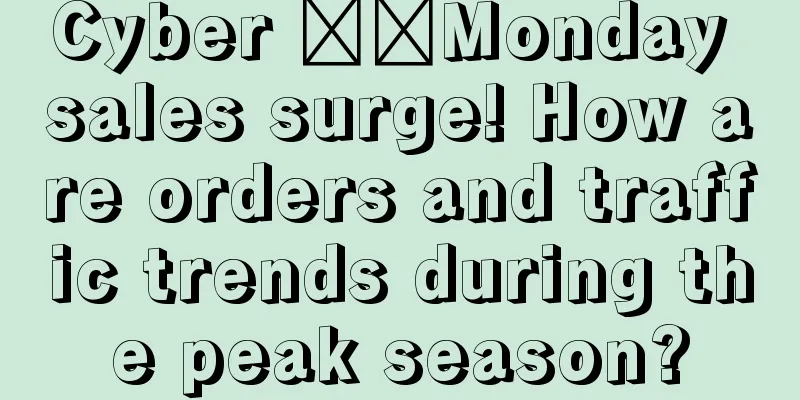Cyber Monday sales surge! How are orders and traffic trends during the peak season?

|
Cyber Monday officially ended this afternoon. This year's Cyber Monday sales were very impressive, with an estimated growth rate of 8.5%! Adobe even raised its sales forecast from 11.2 billion to 11.6 billion overnight! And according to preliminary data, the average discount rate of goods has increased this year. The average discount rate of almost every category exceeds 20%, and the average discount rate of consumer electronics products has even reached 27%. At the same time, offline shopping on the just-concluded Black Friday showed some weakness, with severe weather such as rain and snow in some parts of the United States, resulting in a lack of customers in offline shopping malls on Black Friday. Some offline retailers said that in previous years, the parking lots of their stores were full on Black Friday, and people had to queue for hours to enter the mall, but this year, the parking lots were not even 80% full. Thanks to the weakness of offline sales, Cyber 1 this year was in full swing, and consumers who did not go shopping on Black Friday postponed their shopping plans to Cyber 1. The estimated sales of 11.6 billion broke the record of previous years and maintained a very gratifying growth rate, which is still very impressive even if the increase caused by inflation is excluded. In short, sales have increased a lot in the past two days, but overall, traffic and orders in this year's peak season are still showing a trend of differentiation, no longer concentrated on the day of the event. Amazon's policy of extending the promotion period has aggravated this phenomenon. The proportion of Black Friday and Cyber Monday sales in the entire peak season sales is also declining. In the past, we would say that the effect of LD flash sales is best on the same day, and it is recommended to cancel the schedule other than the same day. Now the traffic is dispersed in the daily shopping season, which means that we have to adapt to and explore the value of event scheduling again. Then there is the work before and after the peak season. In the past, we would do our best to achieve better results on Black Friday and Cyber Monday, and we would do our best to sprint before the event. However, after Black Friday and Cyber Monday, the ranking and traffic would easily plummet, and the orders brought by the big promotion would come and go quickly. Now that the effect of the day is diluted throughout the entire event week, the long-term operation method can be put on the table, using more stable optimization and promotion strategies to maintain a relatively good level during the entire event week (rather than using too much effort and rushing too high at once). In this way, after the event, there will be no cliff-like drop in ranking and traffic, and it can return to normal traffic and orders at a relatively gentle trend. |
<<: Black Friday hits record high? Can Cyber Monday continue its success this year?
>>: Amazon is going to develop an ERP system? Official supply chain integration
Recommend
Shopify launches new tool "Linkpop"! Increasing investment in social e-commerce!
<span data-shimo-docs="[[20,"获悉,据外媒报道,近日Sh...
Global Easy Shopping was declared bankrupt! The company has a debt of 3.3 billion yuan. Here is the official response
The dynamics of cross-border sales are always the ...
What is Ruier International Logistics? Ruier International Logistics Review
Since its establishment in 2006, Realogics has dev...
How to solve the problem of brand abuse displayed during brand registration or authorization?
What I want to share with you today is: How to sol...
What is Papaya Mobile? Papaya Mobile Review
Beijing Papaya Mobile Technology Co., Ltd. (Papaya...
2024 is coming to an end soon. How many of the goals you set at the beginning of the year have you achieved? What are your plans for next year?
Anonymous user My C position I'll go first! I&...
Amazon earthquake! The government is going to make a large number of people unemployed
The rise of cross-border e-commerce led by Amazon ...
New Walmart consultation, the latest Walmart status!
Recently, many sellers have been asking about the ...
North American home furnishing chain Bed Bath & Beyond has reached a cooperation with Casper Sleep!
It is learned that Bed Bath & Beyond, the larg...
12,000 orders per month! Net profit of 1.3 billion in one year! Another Amazon hit takes off...
Everyone says that 2020 is difficult, but cross-bo...
What is JetNet International? JetNet International Review
J-Net International was established in May 2011. I...
Cross-border winter! How can small and medium-sized sellers save themselves under the new mask export regulations?
Today, I believe everyone has been flooded with th...
What is Fangxin Intellectual Property? Fangxin Intellectual Property Review
Shenzhen Fangxin Intellectual Property Agency Co.,...
How does a qualified operator promote an Amazon boutique store?
Some new product promotion steps and promotion mo...
Amazon Flash Sales-DOTD, BD and LD
1. Classification of flash sales Amazon Deal Categ...









